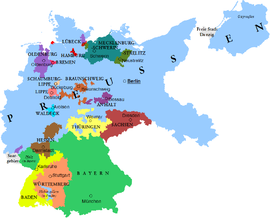
Württemberg Landtag elections in the Weimar Republic
Encyclopedia


Landtag
A Landtag is a representative assembly or parliament in German-speaking countries with some legislative authority.- Name :...
in the Free People's State of Württemberg
Free People's State of Württemberg
The Free People's State of Württemberg was a state of Germany during the Weimar Republic in Württemberg.-1918 revolution:As Germany underwent violent revolution near the end of World War I, the Kingdom of Württemberg was transformed from a monarchy to a democratic republic without bloodshed; its...
, a part of the Weimar Republic
Weimar Republic
The Weimar Republic is the name given by historians to the parliamentary republic established in 1919 in Germany to replace the imperial form of government...
. This was the successor state of the former Kingdom of Württemberg
Kingdom of Württemberg
The Kingdom of Württemberg was a state that existed from 1806 to 1918, located in present-day Baden-Württemberg, Germany. It was a continuation of the Duchy of Württemberg, which came into existence in 1495...
in southwestern Germany, between the end of the German Empire
German Empire
The German Empire refers to Germany during the "Second Reich" period from the unification of Germany and proclamation of Wilhelm I as German Emperor on 18 January 1871, to 1918, when it became a federal republic after defeat in World War I and the abdication of the Emperor, Wilhelm II.The German...
(1871–1918) and start of the Nazi regime in 1933.
The table is an important indicator of the swings in political opinion in this part of Germany between the second and third Reichs, a period when parliamentary democracy came to have real political meaning in Germany. Württemberg is now a part of the modern land (federal state) of Baden-Württemberg
Baden-Württemberg
Baden-Württemberg is one of the 16 states of Germany. Baden-Württemberg is in the southwestern part of the country to the east of the Upper Rhine, and is the third largest in both area and population of Germany's sixteen states, with an area of and 10.7 million inhabitants...
.
In the table below, "Sitze" means the parliamentary seats won in the elections.
| Jahr | SPD | Demokra- tische Volks- partei |
Zentrum | WBP ab 1924: DNVP/WBP 1932: DNVP |
WBB | USPD Independent Social Democratic Party of Germany The Independent Social Democratic Party of Germany was a short-lived political party in Germany during the Second Reich and the Weimar Republic. The organization was established in 1917 as the result of a split of left wing members of the Social Democratic Party of Germany... |
WBWB | Deutsche Volks- partei |
KPD Communist Party of Germany The Communist Party of Germany was a major political party in Germany between 1918 and 1933, and a minor party in West Germany in the postwar period until it was banned in 1956... |
VSB | CSVD | NSDAP |
|---|---|---|---|---|---|---|---|---|---|---|---|---|
| 1919 | 34,5 % 52 Sitze |
25,0 % 38 Sitze |
20,8 % 31 Sitze |
7,4 % 11 Sitze |
5,8 % 10 Sitze |
3,1 % 4 Sitze |
2,7 % 4 Sitze |
- | - | - | - | - |
| 1920 | 16,1 % 17 Sitze |
14,7 % 15 Sitze |
22,5 % 23 Sitze |
9,3 % 10 Sitze |
17,7 % 18 Sitze |
13,3 % 14 Sitze |
- | 3,4 % 4 Sitze |
- | - | - | - |
| 1924 | 16,0 % 13 Sitze |
10,6 % 9 Sitze |
20,9 % 17 Sitze |
10,4 % 8 Sitze |
- | - | 20,2 % 17 Sitze |
4,6 % 3 Sitze |
11,7 % 10 Sitze |
4,0 % 3 Sitze |
- | - |
| 1928 | 23,8 % 22 Sitze |
10,1 % 8 Sitze |
19,6 % 17 Sitze |
5,7 % 4 Sitze |
- | - | 18,1 % 16 Sitze |
5,2 % 4 Sitze |
7,4 % 6 Sitze |
- | 3,9 % 3 Sitze |
- |
| 1932 | 16,6 % 14 Sitze |
4,8 % 4 Sitze |
20,5 % 17 Sitze |
4,3 % 3 Sitze |
- | - | 10,7 % 9 Sitze |
- | 9,4 % 7 Sitze |
- | 4,2 % 3 Sitze |
26,4 % 23 Sitze |
See also
- WürttembergWürttembergWürttemberg , formerly known as Wirtemberg or Wurtemberg, is an area and a former state in southwestern Germany, including parts of the regions Swabia and Franconia....
- History of WürttembergHistory of WürttembergWürttemberg developed as a political entity in south-west Germany, with the core established around Stuttgart by Count Conrad . His descendants managed to expand Württemberg, surviving Germany's religious wars, changes in imperial policy, and invasions from France. The state had a basic...
- German federal election, March 1933

